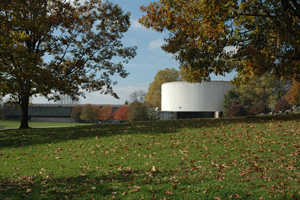
GETTYSBURG, Pa. (AP) – Lovers of modern architecture have won a round in their fight to preserve a half-century-old building at Gettysburg despite efforts by the Civil War purists to demolish the structure to restore the battlefield to its original appearance.
The National Park Service has been seeking for a decade to demolish the Cyclorama Building, built in 1958 by famed modernist architect Richard Neutra to house a massive circular painting of the famous 1863 battle which has been relocated.
The building is near one of the highest points on Cemetery Ridge, a key defensive position where nearly 1,000 Union soldiers were killed or wounded during Pickett’s Charge. The National Parks Service would like to remove the building to preserve the battlesite, but an architectural preservation group says the building is also historically important.
A federal judge in Washington ruled last week that the park service did not follow procedure on the matter. U.S. District Court Judge Thomas Hogan told the park that it must go back and reconsider its 1999 decision to raze the building before it can take any action to knock down the structure.
In March 2009, U.S. Magistrate Judge Alan Kay recommended that the U.S. District Court rule in favor of the suit by the Recent Past Preservation Network and ordered the park to prepare an Environmental Impact Statement evaluating the potential impacts and review alternatives to demolition.
Neither Gettysburg National Military Park nor the National Park Service has commented on the decision. Andrew Ames, a spokesman for the U.S. Department of Justice, said the agency is reviewing it and has not decided on the government’s next step.
Los Angeles architect Dion Neutra, who worked alongside his father on the center a half-century ago, said the Cyclorama was “way up” on his father’s list of the most important buildings of his career. Architectural luminaries like Frank Gehry and Robert A.M. Stern have agreed, sending letters in support of preserving it.
Neutra said his father had a broader vision for the museum than simply housing the 377-foot long, 40-foot high painting depicting Pickett’s Charge.
“He wanted to commemorate the Gettysburg Address as opposed to just commemorating the battle,” he said. “The idea was for a monument to address the notion of reconciliation as Lincoln had tried to do in the Gettysburg Address. We could do that in a dynamic way today.”
Copyright 2010 Associated Press. All rights reserved. This material may not be published, broadcast, rewritten, or redistributed.
AP-ES-04-05-10 1039EDT


